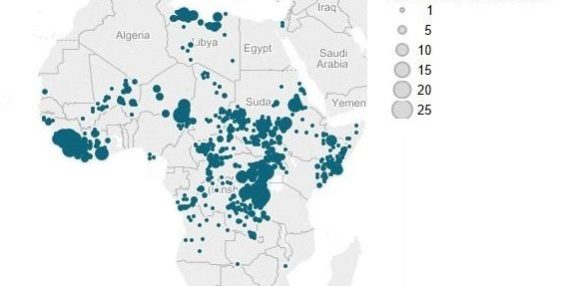Does the use of remote violence indicate weakness in a non-state conflict actor? Forms of ‘remote violence’, such as roadside bombs and improvised explosive devices (IEDs), enable armed groups to attack targets that they do not have the capacity to face directly. As a result these weapons have been described as ‘weapons of the weak’ (Denselow, 2010).
Merari (1993) argues that remote violence is used by groups who lack the will or ability to take over territory but who seek to dictate government policy and public behaviour through fear. In contrast stronger rebels which can challenge the state’s sovereignty over its territory may use more conventional military arms suited to direct military engagement.
The data does lend support to this theory, if the ability to seize and control territory is taken as a marker of strength. Since 1997, 4.57% of recorded battles in Africa have resulted in a non-state actor taking over territory. However, if the data is filtered to only include confrontations involving the use remote violence, this percentage drops considerably to 0.8%.
Figure 1 shows a map of all locations where rebels and insurgents have seized territory from either the government or rivals. Figure 2 shows the location of battles where bombs and IEDs have been used and where more conventional heavy weapons have been used. The locations of events involving remote violence shows some spatial correlation to the location of battles where non-state actors gained territory, but less so than the location of battles involving heavy conventional weapons. There are also areas, such as Algeria and Egypt (outside of the Sinai), where remote violence has been common but where non-state actors have failed to win territory.
The relationship between remote violence and relative strength is also illustrated by the shift in the use of weaponry by Al Shabaab. Al Shabaab was pushed out of Mogadishu by African Union troops and has since lost significant amounts of territory it used to control (Associated Press, 6 October 2014). Figure 3 shows that since 2011 Al Shabaab’s use of remote violence has drastically increased relative to its use of more conventional heavy armaments suggesting that the group has deferred to using the ‘weapons of the weak’ as it has become weaker.
As a result, there is evidence that remote-violence is a weapon of the weak. But, the example of Al Shabaab raises the important point that groups will often use multiple types of weaponry and tactics at any one time. Even when Al Shabaab is comparatively weak, the group still employs heavy armaments. It is perhaps better to conceive of remote violence not as the preserve of weak non-state actors, but a low-cost tactic to be used in tandem with other types of violence.
References
Associated Press. 2014. ‘Pro-Somalia Troops Secure Last Significant al-Shabaab Bastion.’ The Wall Street Journal, 6 October 2014 http://online.wsj.com/articles/pro-somalia-troops-secure-last-significant-al-shabaab-bastion-1412585488 [Accessed 29 October 2014].
Denselow, James. 2010. ‘Roadside bombs: weapons of the weak.’ The Guardian, 18 June 2010, http://www.theguardian.com/commentisfree/2010/jun/18/roadside-bombs-afghanistan [Accessed 28 October 2014].
Merari, Ariel. 1993. Terrorism as a strategy of insurgency. Terrorism and Political Violence 5(4): 213-251.








